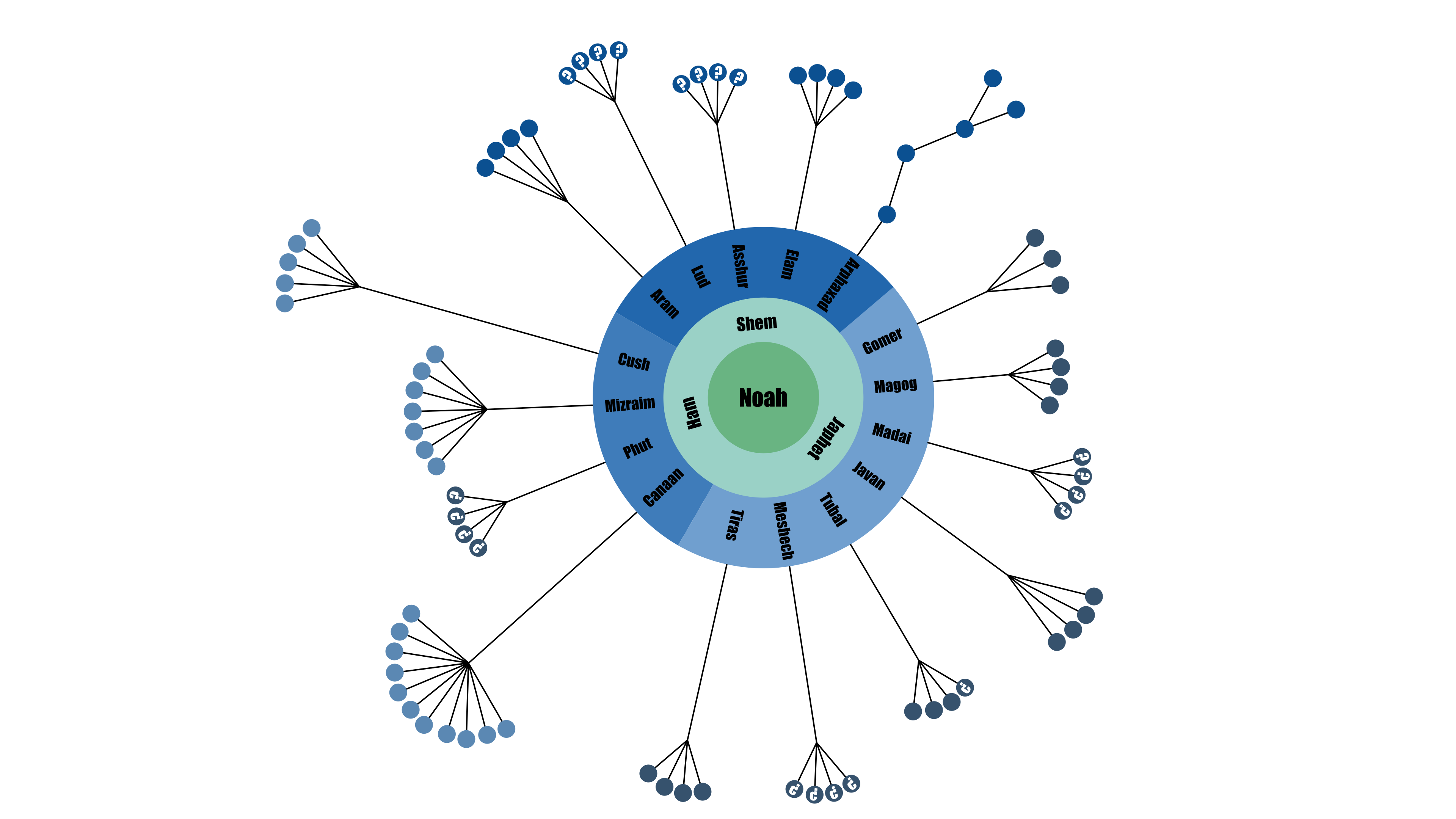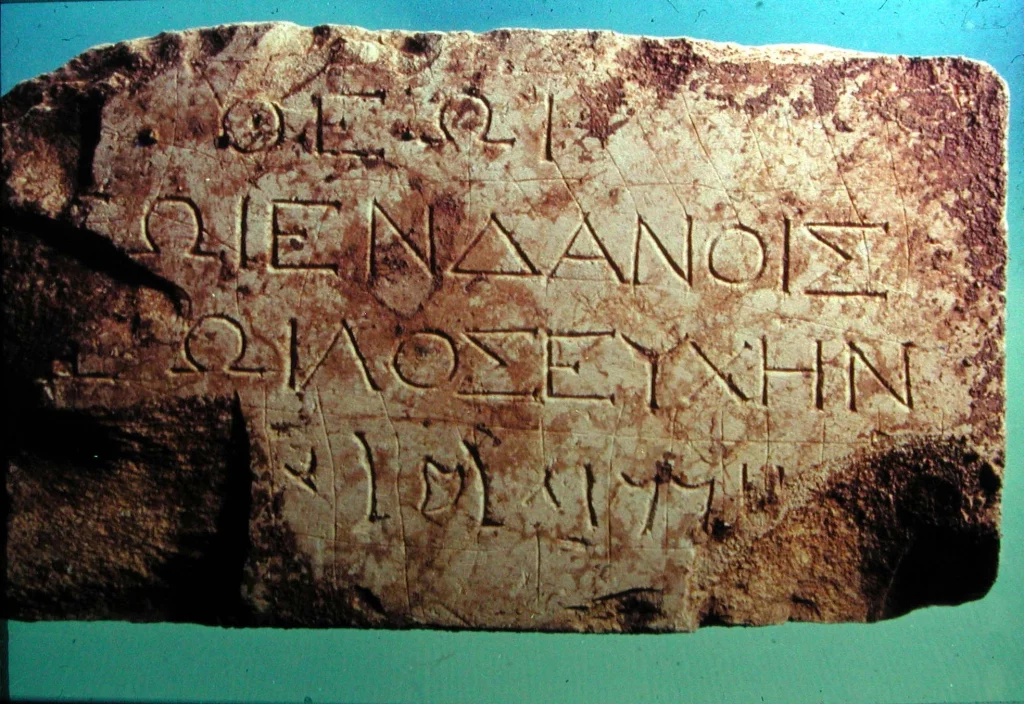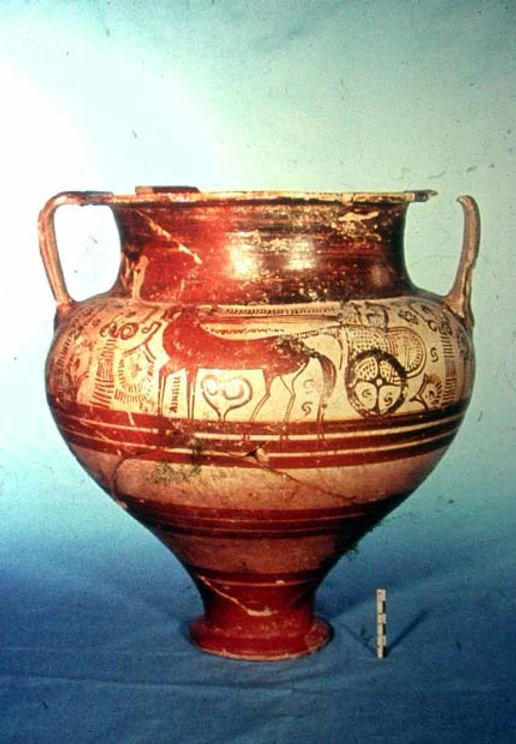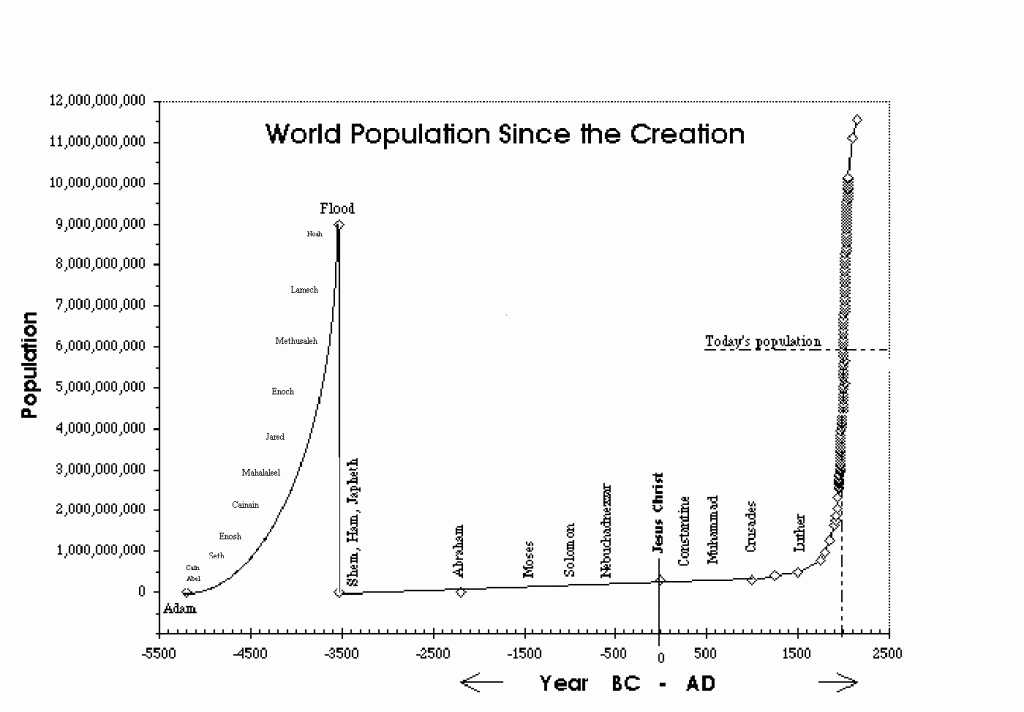The descendants of Japhet and the Israelite tribe of Dan
By comparing the Indo-European languages, DNA, and history, it is clear Europe is genetically connected or has common ancestors. Names of groups have changed depending upon the languages of the historians writing about them. Some names of tribes change with a new beloved leader. Sometimes a name is changed because of an event, or because of some need to distance themselves from another group from the same family. This is all typical human behavior and happens all the time. Therefore, many of the European groups that historians call by different names originate from the same group of people.
A lot of the names we have now on the ancient groups come from Greek and Roman historians.
Because the Bible tells us that Javan’s children (Japhets son) were the first to populate the coastlines westward and later traded by the coast, it is reasonable to assume they were the first southern Europeans, and the Bible also tells us they cooperated with the Phoenicians (descendants of Canaan/Ham) who immigrated to coastal towns to pursue trade. What we do see genetically and historically is that some of the first coastal tribes were spread further west. Some remained in the south. The Celtic and Gallic, Greek, and early Latin-speaking groups appear to be first in what we now call Italy, France, and Northern Spain. Remember the closer to the sons of Japhet they were in time, the closer they would appear genetically and this is in part why it is hard to determine one from the other and why we have to look at the greater immigration to Europe to get a better view. In what we now call Italy, many European tribes were coming and going. Some of the groups came from the mountains in the north towards Italy. Some came through the coast. Celtic tribes also spent time in Italy and eastwards. All however, seem to be the descendants of Japhet with a smaller percentage of Ham and Shem, which is to be expected considering the trade routes.
The Bible reveals a tribe of Shem intermixing with the children of Japhet early on.
This tribe is none other than the tribe of Dan, the same tribe excluded among the 144,000 in the Book of Revelation. The tribe of Dan appeared to not be faithful after they entered Israel. Already from the judge’s era, they created their own religious system, with idols and a priest (Jdg 18:30) They also welcomed Jeroboam’s apostate religious direction, and the golden calf was placed in their land, as an alternative place for worship. (1. Kings 12:29). Dan was the first son to be born to Jacob from Rachel’s handmaiden.
Although the Bible does not let us know their final destiny after the diaspora, it does give us several clues:
“Gilead abode beyond Jordan: and why did Dan remain in ships? Asher continued on the seashore, and abode in his breaches” (Jdg.5:17)
Dan was among the traders and feared sea people of the Mediterranean. Often in ancient writings, they are referred to just as “the sea people” among the different other groups of sea people. Some were Phoenicians, some were from the tribe of Javan, and some were from the tribe of Dan. Many ancient tombs excavated now claimed to be the ancient Phoenicians are really descendants of the tribe of Dan who were similar in style, and time, through intermarriages and traveled from the same areas as the Phoenicians did. The Bible reveals that the tribe of Dan were also traders with Javan (a son of Japhet): “Dan also and Javan going to and fro occupied in thy fairs: bright iron, cassia, and calamus, were in thy market” (Eze.27:19).
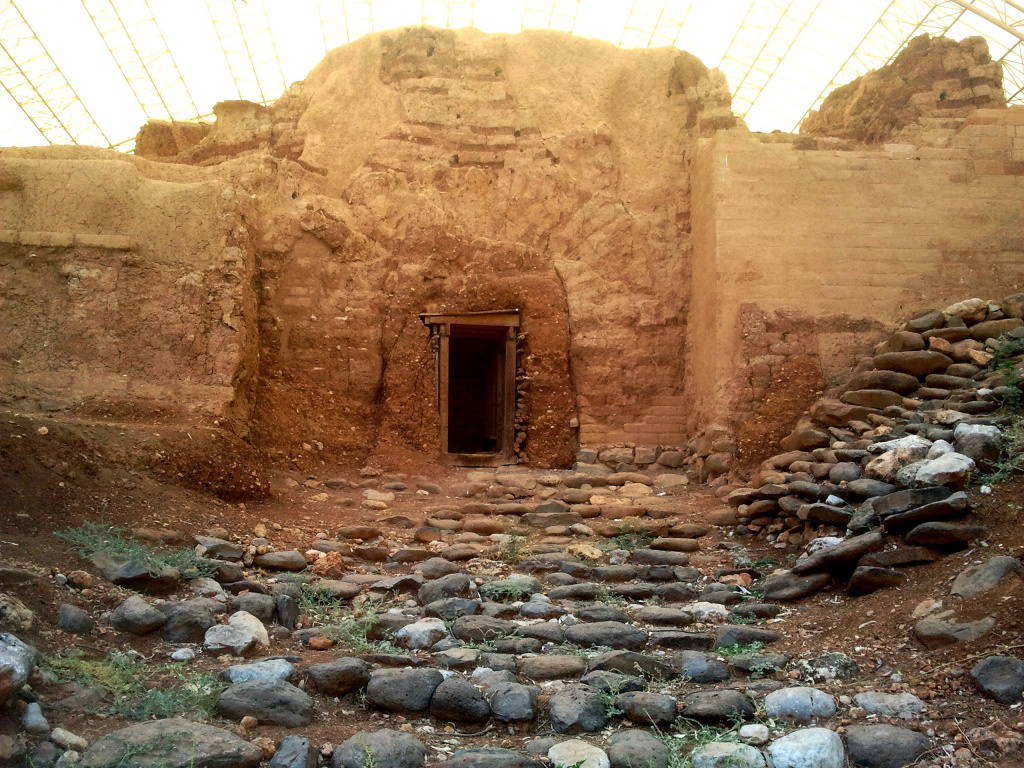
Ancient Greek records confirm that the tribe of Dan early settled among the Greeks (Javan) and even archeological sites from ancient Dan in Israel show early Greek inspiration (or they inspired the Greeks). In Tel Dan, they have found a spectacular treasure-filled Mycenaean tomb from the Late Bronze Age. The Greeks called them Danaus, or the Danaids. And one of them was even the King of Argos (Peloponnese). The Greeks claimed Dan was from Egypt and the Phoenicians because they did come from Egypt and settled in the land of the Canaanites, who were the Phoenicians. Therefore, historians and genealogists will at times mix a tribe of Shem with the Phoenicians and even with the Philistines when testing tombs.
(Diodorus Siculus, Book 40; William Ridgeways Early Age of Greece (s. 220) dating Danaan-Exodus from Egypt as 1450 BC, History of Etruria, The Encyclopedia Judaica (5:1257, Lysimachus of Alexandria (355-281 B.C.)
G.F. Schomann stated, “Even among the ancients, some considered that the [Danaan] settlers who arrived [in Greece] from Egypt were at any rate not of Egyptian descent, but adventurers of Semitic race, who, having been expelled from Egypt, had some of them turned towards Greece,” (Antiquities of Greece, p. 12).
In his Ethnology of Europe, Dr. Robert Latham commented, “Neither do I think that the eponymous [i.e., founder] of the Argive [Greek] Danai was other than that of the Israelite tribe of Dan; only we are so used to confine ourselves to the soil of Palestine in our consideration of the history of the Israelites, that we . . . ignore the share they may have taken in the ordinary history of the world” (p. 137).
The book of Judges in the Bible reveals Dan mostly stayed on the ships rather than committing to their land in Israel. This shows us that they are among the earliest people who spread to Europe during the early Iron Age, but also the late Bronze Age according to some sources. Interbreeding with Europe so early on while the population still was low compared to now, means the tribe of Dan would today count millions among other Europeans, especially around coastal Europe. This can be seen in genealogy haplogroups from ancient graves as well as modern people. A hundred thousand Dan’s then might today be many, many millions. Although we can not say who is who for sure, we know enough to understand that there would be traces of Shem, even Israel in Europe early on.
Among the places Dan would have gone with his ships together with Javan are the west and east Mediterranean, even to Sardinia, Sicily, and Spain. They did not keep their original Semitic languages but ended up speaking Indo-European languages all depending on where they settled. This was a curse spoken to all unfaithful Israel: “Indeed, with mocking lips and foreign tongues, He will speak to this people” (Isa.28:11) Which we see fulfilled in part later during Pentecost where the disciples had been spiritually given languages to reach the Jewish visitors coming from other lands: And they were all amazed and marveled, saying one to another, Behold, are not all these which speak Galilaeans? And how hear we every man in our own tongue, wherein we were born?” (Acts.2:7-8) These were among the still faithful, the unfaithful became part of the countries and tribes they lived with. Such was likely the case with the tribe of Dan who now would speak many different European languages.
Archaeologist Dr. Cyrus Gordon states that they later sailed from Greece to other European coastlands, including Ireland and Denmark. In his book, Before Columbus, Gordon speculates how far Dan went. “Virgil also designated the Greeks as ‘Danai.’ Bold scholars see the influence of the Danites in Irish folklore. . . and in the name of Danmark (‘Denmark’): the land of Dan . . .” (p. 111).
There are indeed indications that the Danaan of Ireland, Cornwall, and Scotland, the Danaan of Greece and Italy, as well as some of the Danes of Denmark, were Israelites from the tribe of Dan. If correct, Dan became part of Magog as well as Mesech, Tubal, Tiras, and Javan. We know this also happened with the lost tribes of Israel who too became scattered among the lands through human trafficking, displacement, wars, and so on. The distance between when Dan traveled the sea and the second diaspora is so great that in most cases they will appear to be closer genetic to the countries they settled in than to the Jews of the second diaspora, only the haplogroup would reveal their true forefather. Regarding Israel and the two diasporas, one part remained among the tribes of Shem in the Levant, and the rest was spread among the nations especially the coastal regions of Japhet. This can also be seen in Jewish genetics.
The important point here is that it will be hard to differentiate between descendants of Dan, the Greeks, and Phoenician merchants mingled with Japhet’s other children as all have interbred with each other over many centuries, even three millennials. Some tombs that are excavated and deemed Phoenician or Greek, yet show a Semitic haplogroup, could be the tribe of Dan or from Israeli nomads. There is not enough knowledge or discoveries which sometimes results in ancient groups given the wrong haplogroups. Excavators analyzing ancient graves don’t know if it is a settlement of another group within another nation, they don’t know if they are slaves brought through warfare, they know very little.
However, the variants coming from different sons of Noah could be seen in the paternal haplogroups. They do not tell, however, who is more related than someone with another haplogroup as you can have many in a family from one line and just having a father from another family and it changes your paternal haplogroup.
Another prophecy about Dan goes as follows: “Dan shall judge his people, as one of the tribes of Israel” (Gen 49:16)
Samson was one of those judges. But Israel had many judges and not all came from Dan. This can not have been what Jacob meant when he uttered his prophecy.
However, if Dan intermingled with Japhet’s children early on, they would also be among the groups that came and dispersed Judah later, which was a judgment from God.
Israeli and Jewish diasporas
D uring the two Diasporas, other tribes of Judah also spread among these lands, mixing their seed with Japhet. We see this in the Bible where Paul visits and mingles with many Jews living in what we today call Turkey, Greece, and Rome. During the first diaspora when the northern tribe spread, they spread into Semite territories in the north and east. Paul also wrote to the Galatians, who were of Celtic origin.
Evangelical genealogists switched the place of Japhet and Shem.
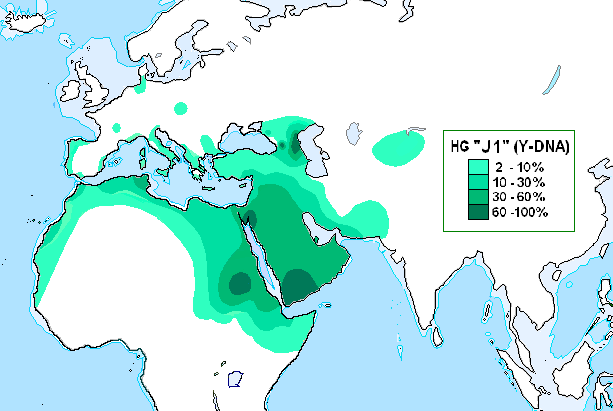
The reason understanding history correctly is so important right now is evangelical genealogists have started to confuse the descendants of Japhet with the descendants of Shem and vice versa. One of them is Dr. Nathanael Jeanson from Answers in Genesis who has published a book on the topic, switching the two groups in his eagerness to combat evolution theory. He, as well as others in Answers in Genesis, are paternal haplogroup R1b, making them part of the Magog-Meshech-Tubal groups. Evangelicals in the United States and Europe have long fantasized about being the lost tribes of Israel, or at least descendants of Shem, viewing themselves as God’s new representatives in the world. This view fits poorly with being descendants of Magog, whom God will judge in the end times. If this makes them biased and switch the descendants of Shem and Japhet, only they know. Unfortunately, as we will see, confusing these things will ultimately mean we understand certain passages in the Bible wrong. And as we investigate, the Bible shows us who is who. In addition, Levites, Jews,
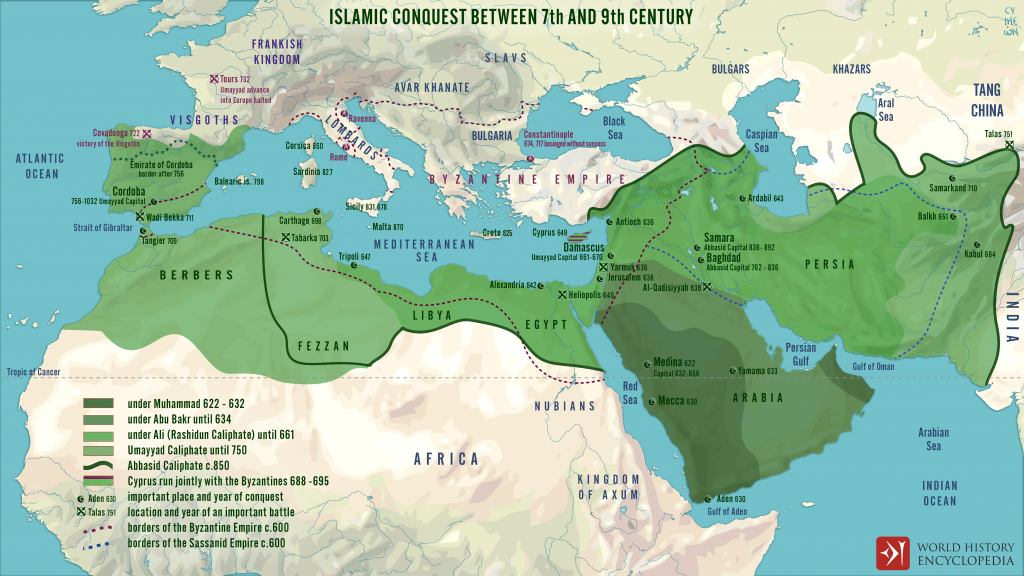
and Arabs who have ancestral lists that go all the way down to Abraham have the paternal haplogroup group J1. We can therefore know with certainty that the J gene belongs to Shem.
The mix-up is in part due to archeologists being confused about the great mingle of people in the early Levant while at the same time disregarding the Biblical accounts explaining these things. Secondly, many get stuck with early Europeans having the paternal group I1 and I2, which they assert has to belong to Shem if J is Shem (Research so far currently shows that J and I likely had the same forefather which they name JI).
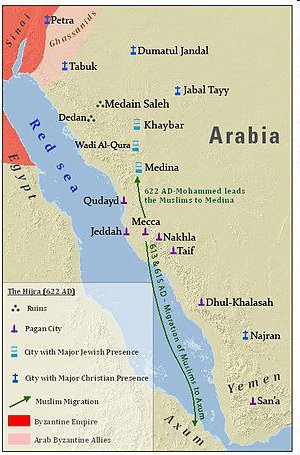
It also exposes why ‘Answers in Genesis” is confusing the Christian world making them think they are Semite and Arabians are the children of Japhet to be judged.
Intermarriage between the tribes at the very beginning would cause paternal haplogroups to appear as they do. Several such example is seen in the Book of Jubilee, where Kainam of the tribe of Shem is married into Japhet’s family. The presence of Dan and Judah in the Mediterranean coastline has also left great traces in paternal haplogroups. The overall evidence, and old writings, including genetics, show however that despite a paternal haplogroup from Shem mixing with Japhet, it does not change who they are.
The Kainam – example
“To show how easily one haplogroup could get mixed up with another we will use Kainam, great-grandson of Noah, as an example. He is the forefather of Abraham and the Hebrews, but he is left out of the genealogy lists in the Old Testament. He is added again in the Septuagint and the New Testament gospel of Luke. According to the book of Jubilee Kainam was the son of Arpachshad gone rough. In the Old Testament, they skip his name and write Kainam’s son Selah as Arpachshad’s son instead. We don’t know why for certain. He could have left his son to be raised by his father, or his son could have chosen to be faithful and therefore included on the list instead of his father.
The story in the book of Jubilee tells that Kainam found a cave with astronomical drawings whereupon he felt chosen to represent this religion: “And he found a writing which former (generations) had carved on the rock, and he read what was thereon, and he transcribed it and sinned owing to it; for it contained the teaching of the Watchers in accordance with which they used to observe the omens of the sun and moon and stars in all the signs of heaven. 4 And he wrote it down and said nothing regarding it; for he was afraid to speak to Noah about it lest he should be angry with him on account of it. 5 And in the thirtieth jubilee, [1429 A.M.] in the second week, in the first year thereof, he took to himself a wife, and her name was Melka, the daughter of Madai, the son of Japheth, and in the fourth year [1432 A.M.] he begat a son, and called his name Shelah; for he said: ‘Truly I have been sent.’
Kainam serves as an example because he married into Medai’s family and if rejected by his own might have traveled with them where they went. If not him, someone else might have been in a similar situation early on. This happens all the time throughout human history, there are black sheep joining other groups. If someone, anyone, early on went with their wife, or wife with their husband’s family that is all it takes to change the genetic landscape of a region as the population grows.
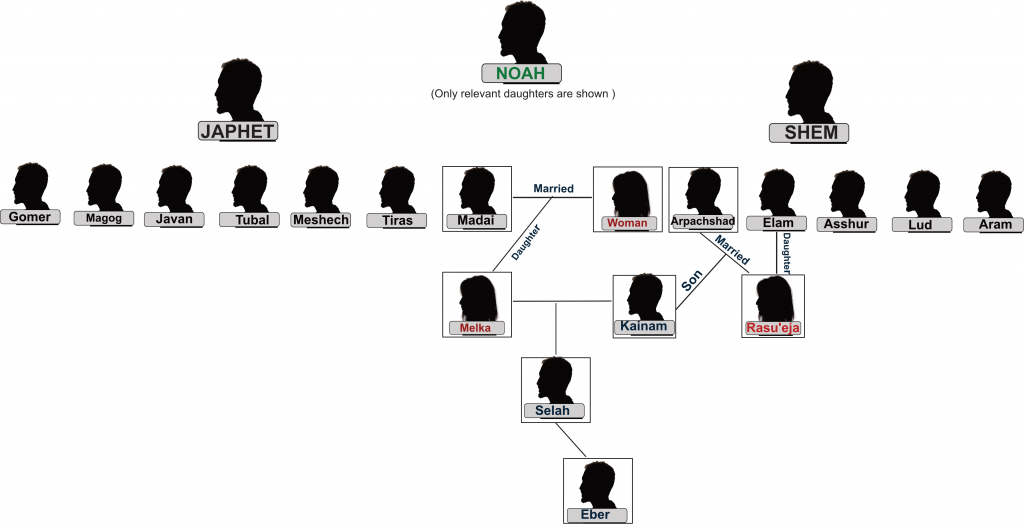
Cracking the haplogroup -code
Who can solve the haplogroup code? Many think they can, but the answer might be lost because of early misconceptions. The problem with some scientific conclusions is that if they are on the wrong track at first, then everything they build upon becomes wrong. It can then be hard to retrace back the steps. This is why it is still crucial to listen to all of the Bible clues.
The genetic tree is constantly being worked on as more information grows. The biggest problem with the evolutionist’s haplogroup tree is that its whole base is wrongly designed.
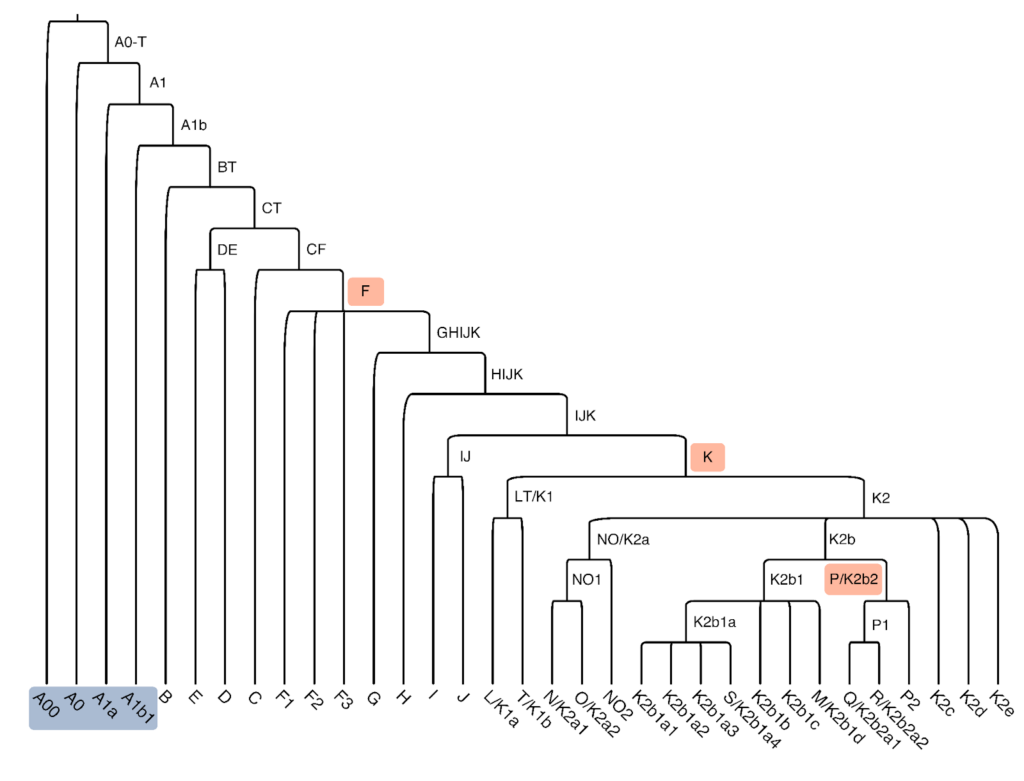
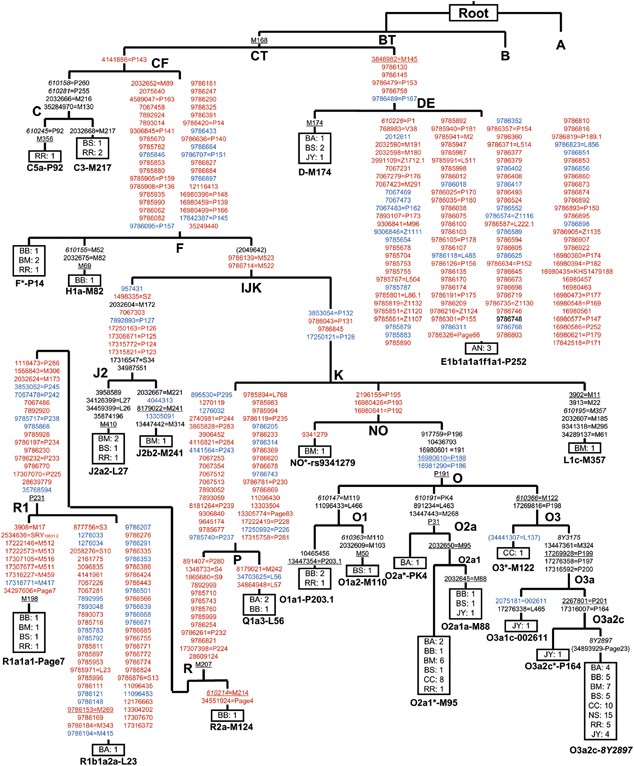
This tree is based on the length of mutation and assumed age. By using the presumed age of the haplogroup they then create a tree with the oldest first and what they believe is the youngest last. In this way they assert, since all are related, that the “youngest” mutated from the “oldest”.
They then place this tree into their already assumed theory of evolution, placing ten thousand years in between each mutation, so that humans end up as old as they want them to be. The claimed “oldest” mutation is found in Africa and they then claim this supports the “out of Africa” theory.
What is wrong with it:
1. The old haplogroups and the young haplogroups, do not represent time in the way they think.
2. Main haplogroup mutations did not happen over thousands of years.
3. The assumed “younger” main mutations did not always come out of the “older” main mutations. Proof of the “missing links” must be provided to confirm it.
The Biblical haplogroup tree
- The Bible teaches us that all men came from three men and three women.
- They spread from Northern Mesopotamia, not Africa.
- Only the descendants of Ham went to Africa (with some exceptions, as people traded and were in alliance with each other).
- All main haplogroups come from the same source, three men.
Asserting the Biblical information given to us, haplogroups should be arranged from a circle going out and not as a “tree”. The first thing we have to do to respect the Biblical narrative is to even out the age of the main haplogroups.
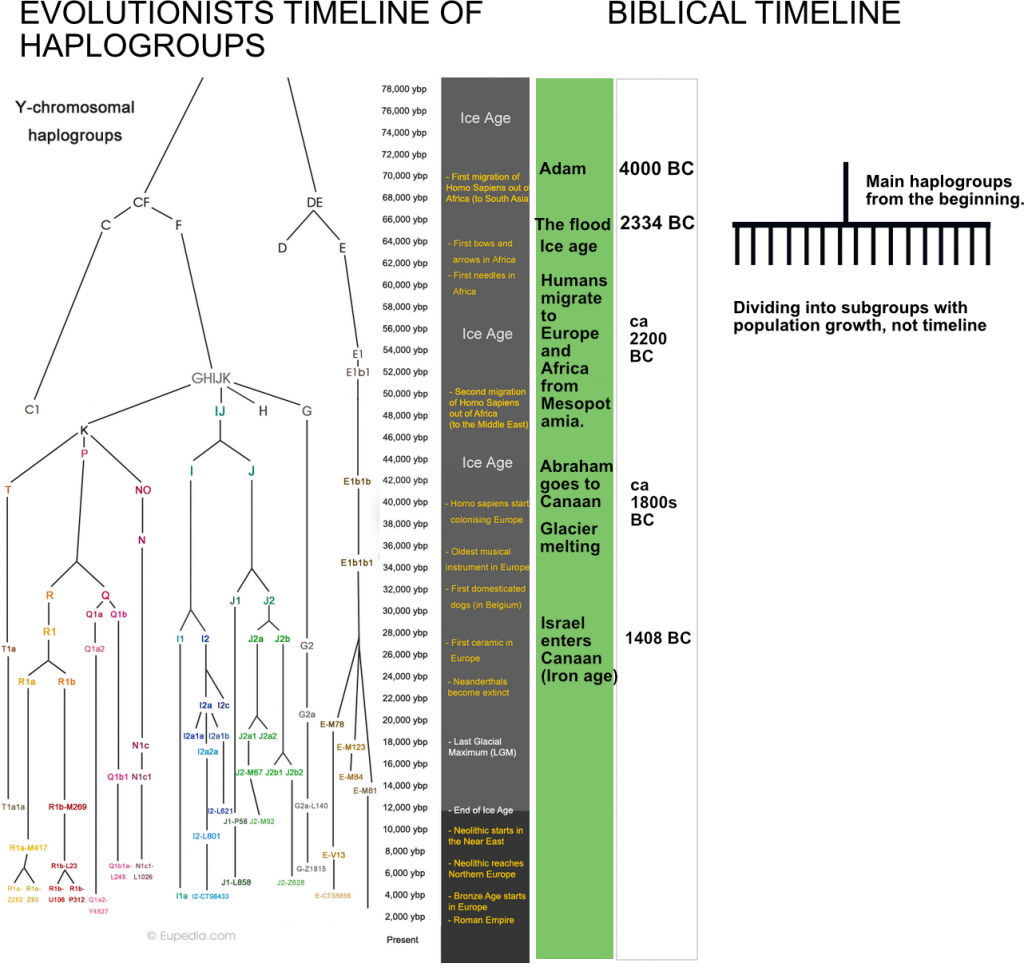
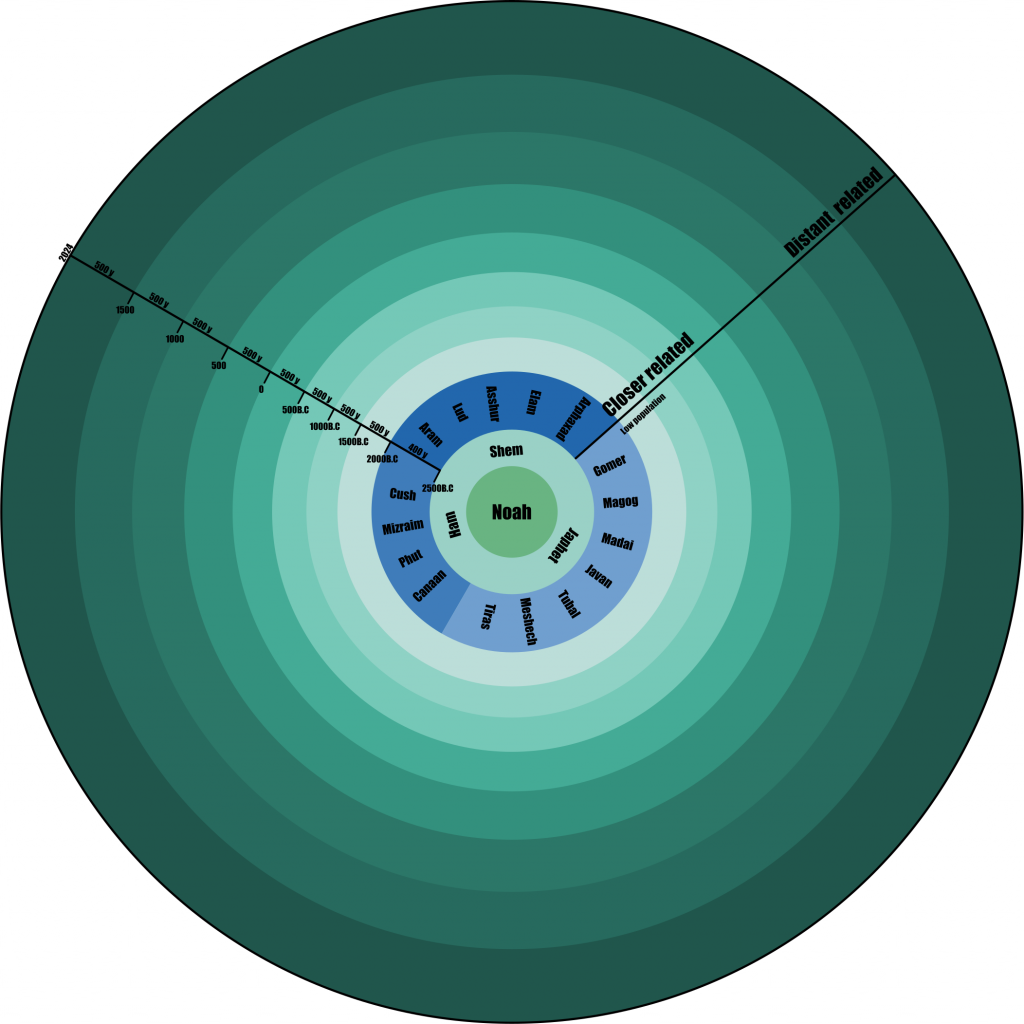
How the paternal haplogroup dispersion should look like according to the Bible:
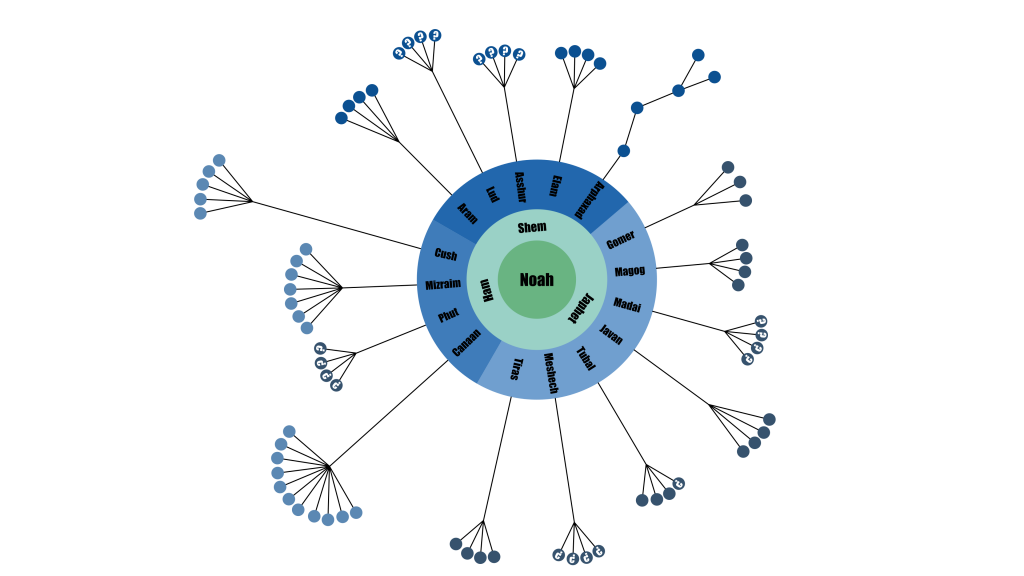
Differences in measuring familiarity:
Evolutionists: Do not know when the different human families separated, and have ten thousand years to spare. This means as they excavate for instance Neolithic or early bronze age graves they are expecting them to be further apart family-wise than what the Bible claims.
Creation/Flood: The first few generations would be closer related than we are today to our own forefathers. As an example, the first generations after the flood were cousins. The people of the Neolithic era will look closer to each other in relation than they do to us. The great-great-great grandson of Ham is closer related to the great-great-great grandson of Shem than a distant descendant of Shem is related to Shem. This is why many of the earlier populations appear more closely related despite being from different sons of Noah. The haplogroup mutations are the only real source we have to separate who is from which son. However, there are several ways of showing family relations than the haplogroups. Depending on which method is used, we can therefore get different results when looking at the ancient populations.
Did the parent haplogroups come right after the flood?
Some of the oldest graves tested are from the first thousand years after the flood.

Here we see that they already have the known paternal mutations (haplogroups) in place. If they were already R’s and J’s in the Neolithic period, the main haplogroups have to come directly from Noah’s sons.
The Biblical narrative does not have ten thousand years to take from. And what is called the Neolithic period by evolutionists was right after the flood Biblical-wise. Therefore we can pinpoint that the diversity of the parent haplogroups happened right after the flood and not over time. The I and the J haplogroups are evidence of this, and so we will use them as an example. They are both claimed to be fairly young compared to the other parent haplogroups and claimed to derive from other parent haplogroups, even African haplogroups which they claim have lasted for nearly 100 000 years. However, if we know for certain that J1 is the Abrahamic lineage (seen through genealogy family trees) we can pinpoint the time of the mutation. Abraham was born only around 380 years after the flood.
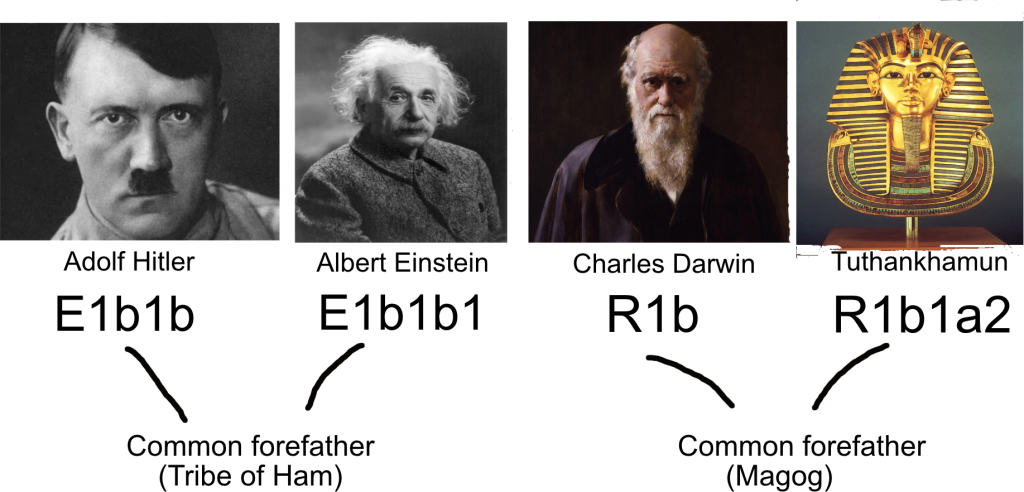
Abraham’s forefather is according to the Bible the first child to be born after the flood. His name was Arpachshad. If the parent haplogroup belonging to the descendants of the first child born is counted among the youngest by evolutionists, and it is found today as well as in ancient graves in Anatolia, then it is a suggestion that haplogroup mutations are related to the age of the father at the time of the sons birth. Likewise, the I gene is said to be among the oldest haplogroups in Europe. This means they came right after Babel and had to have been developed early on as well.
Research on mutations is still at the very beginning.
The following is a hypothesis by thirdangelsmessage.com.
Hypothesis 1: Age of the father at the time of birth
Noah was five hundred years old when he started having children. His father was 182 years old, and even that was old. Enoch was only 65 years old when he had his son Methuselah, Noah’s grandfather. Having children at the age of 500 was old even in the pre-flood timeline. His sons were over a hundred years old when they began to have children. Only research can show us if other factors may play a part like if they were sick or drunk when conceiving the child or biological changes. Let us put that aside for now, and focus on the age of the father. Research is still at its very beginning in looking at the possibility of old fathers giving more mutations to their offspring then younger fathers do. Therefore there is still very little research on it and when ongoing, they are forced to make it fit somehow with the evolution theory.
Haplogroups E and R have the shortest phylogenetic branch lengths and the lowest somatic mutation rates. While what they think are older parent haplogroups might actually be tied to the age of the father. If Shem who became 600 years old, for instance, was 300-500 hundred when he had his youngest son, not only might that son be born with a 200-400 age gap compared to the oldest, but the old age of Shem might have caused that son more or different mutations. Even if there were only a hundred years between the youngest and the oldest, fifty or thirty, we might still see a difference in the mutations given to each son.
Naturally, if this is what happened the visual genealogy tree will look very different.
Understanding haplogroup mutations has to be approached in a different way one way or another. We see the main paternal haplogroups are about the same number as the sons of Noah. Noah had 16 known grandsons. Some paternal haplogroups appear to belong together but might therefore not. If they represent the grandchildren of Noah, all three sons would have a similar haplogroup pool to where the others mutated from. Therefore “cousins” might appear closer than even siblings when it comes to mutations among these first children. What would change the game even more is if Shem and Japhet were identical twins. One is said to be older than the other, yet that was the case with the other twins in the bible as well. Esau was said to be the oldest, simply because he came out of the womb first. If Shem and Japhet were twins all their children would appear as siblings on the paternal side. There are other twins in the Bible, like Judah’s sons Perez and Zerah. Ham’s first descendants could involve twins, or Japhets’s children Magog and Medai could have been twins. Not knowing who might or might not be identical twins, makes it harder to distinguish some mutations and their descendants. Knowing the possibility of twins when the parent haplogroups were formed, helps us see that some of the siblings might appear more closely related mutation-wise than others. Because Noah’s sons lived so long we know they outlived several of their descendants with shorter life spans. That means that in theory, Shem could have fathered a child even after his great-grandson had died. Not saying it happened, but it could have. This would ultimately mean that a mutation from Shem could be three hundred years older than a mutation moving on from his grandchild by a son in his younger days. Then the mutation rate of his first son’s descendants would appear older than that of his youngest son’s descendants.
If it did not happen with Shem, it could have happened with his children or his brother’s family. Had this happened, the child of his old days would have been more closely linked to the parent’s haplogroup than great-grandchildren coming much earlier from the same ancestor. The fact that the first generations after the flood lived for so long gives us a different challenge to understand the haplogroup mutations than what evolutionists go by when they research.
Mutation rate would from there be tied to population growth. The more children a tribe has, the quicker the mutation will spread and the faster its possibility of mutating.
Although the Bible tells us Ham is the youngest it is still unclear who is the oldest of Shem and Japhet. It does say one is older, but when Rebecca had twins, Esau and Jacob, the firstborn right was given to the one who was born first. So we just don’t know if similar mutations came from Shem and Japhet’s descendants or when the mutations took place at all. Lastly, we can not trust the genetic tree at this time because they make some main haplogroups younger than others based on mutation rate, which science now shows us can happen at different speeds. Thus what is thought to be a young haplogroup, might be older than they think.
The point is that we must not let the appearance of the present genealogy tree change what the Bible and other historical sources tell us.
Hypothesis 2
In the years after the flood, there could be, we don’t know if there was, but there could be, a more frequent mutation rate coming from one son compared to another if there was a century or two between sons from the same father. If this was the case with one son of Noah, or two or even three, it could also explain why there are people living today with different mutation rates than others. A third hypothesis could be the reality of both hypotheses. In these cases, the two groups from Shem could have two very different haplogroups.
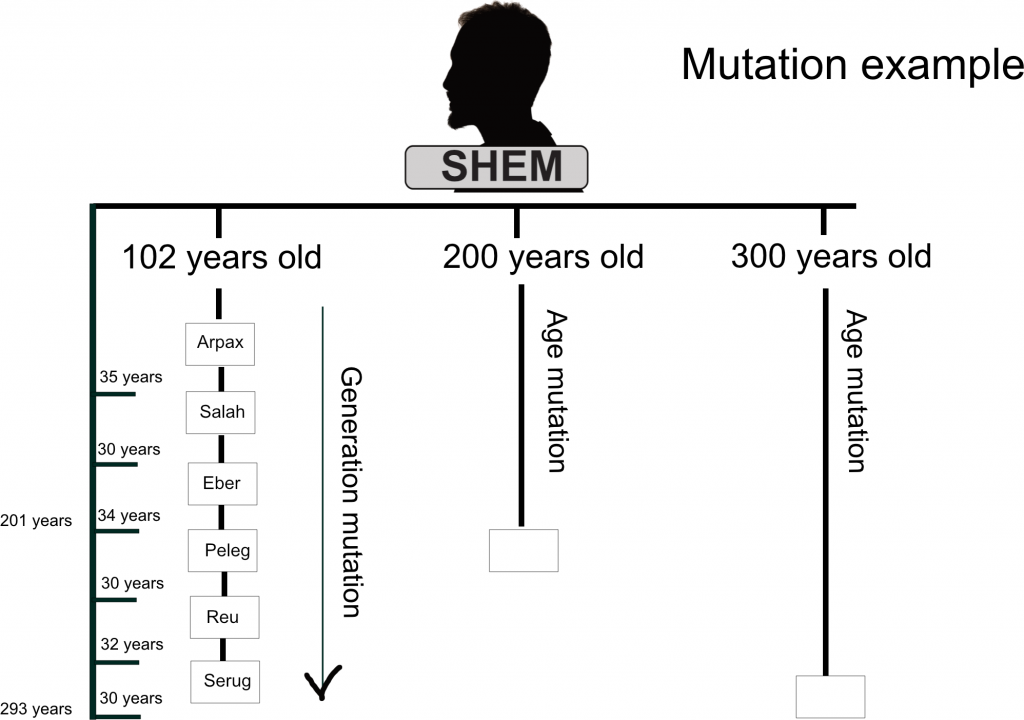
The identification of Magog
From comparing history and genetics it seems clear that Magog has haplogroup R, and especially R1b.
Even if some would quarrel with this discovery, God has made it impossible to remove Magog from Europe. The Bible says: “Son of man, set thy face against Gog, the land of Magog” (Eze 38:2) When God reveals about the Gog and Magog war, he makes sure to not just mention the people of Magog but also the land of Magog, the territory given him. He tells Ezekiel to look towards that land to find out what will happen next. This shows this land is where the planning happens. The children of Japhet were given North and West, thus the land of Gog is in Europe no matter whether we wish it to be or not. Ezekiel together with Revelation shows that this prophecy is in the future, making the land of Gog still that of Magog till the very end, meaning not tribe of Shem is now in the land of Magog.
When mentioning Gomer in the same chapter He says: “house of Togarmah of the north quarters” (Eze 38:6) And another of Gomer’s sons showing that two of his sons is in the north. “bring against Babylon an alliance of great nations from the land of the north..call together against her the kingdoms of Ararat, Minni, and Ashchenaz” (Jer.50:9 & 51:27) When the Gog and Magog war begins we see them all coming from north, Magog, Gomer, and Togarmah together: “And thou shalt come from thy place out of the north parts, thou, and many people with thee, all of them riding upon horses, a great company, and a mighty army” (Eze 38:15) However why God says Gomer is in the North but they meet up in the north to attack Jerusalem is explained by the fact that they come “upon horses”, meaning the land-way. There is no other landway from Europe to Israel except through the Caucasus, the territory of Gomer. Naturally today it is possible to come by Bosporus if we use bridges, but they did not exist at the time of Ezekiel thereby the meaning of them coming against Jerusalem through the Caucasus, is understandable then and now. The main reason all of these details matter is the clues God gives to where the land of Gog is when we add all the information.
This includes these details, but also the “horn” that came from the West in Daniel’s prophecy, Europe divided and being the last and most powerful powers in the world.


